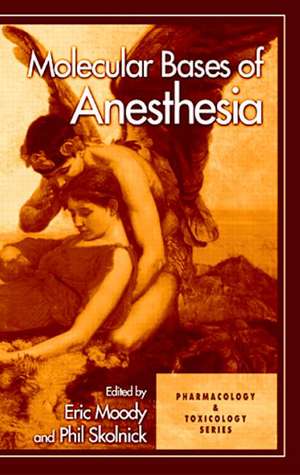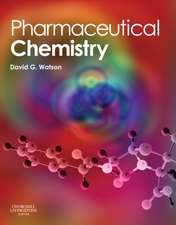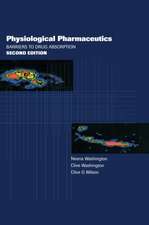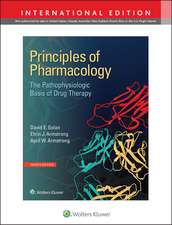Molecular Bases of Anesthesia: Handbooks in Pharmacology and Toxicology
Editat de Eric Moody, Phil Skolnicken Limba Engleză Hardback – 28 dec 2000
With contributions by leading experts, this timely book includes chapters on how to evaluate theories of anesthesia in general and includes discussion of some of the techniques, such as genetics, that can be used to address problems. Also discussed are anesthetic actions at major brain targets with a special emphasis on ion channels and areas of controversy in the field.
This reference provides a broad survey of anesthetic actions, including hyperbaric pressure and anesthesia; volatile anesthetic interactions with proteins; and structure activity relationships of volatile anesthetics. Molecular Bases of Anesthesia stands alone as an in-depth, authoritative guide.
Preț: 1931.22 lei
Preț vechi: 2355.15 lei
-18% Nou
Puncte Express: 2897
Preț estimativ în valută:
369.66€ • 401.66$ • 310.71£
369.66€ • 401.66$ • 310.71£
Carte tipărită la comandă
Livrare economică 21 aprilie-05 mai
Preluare comenzi: 021 569.72.76
Specificații
ISBN-13: 9780849385551
ISBN-10: 0849385555
Pagini: 348
Ilustrații: 6 Halftones, black and white; 17 Tables, black and white; 6 Illustrations, black and white
Dimensiuni: 156 x 234 x 22 mm
Greutate: 0.6 kg
Ediția:1
Editura: CRC Press
Colecția CRC Press
Seria Handbooks in Pharmacology and Toxicology
ISBN-10: 0849385555
Pagini: 348
Ilustrații: 6 Halftones, black and white; 17 Tables, black and white; 6 Illustrations, black and white
Dimensiuni: 156 x 234 x 22 mm
Greutate: 0.6 kg
Ediția:1
Editura: CRC Press
Colecția CRC Press
Seria Handbooks in Pharmacology and Toxicology
Public țintă
Professional and Professional ReferenceCuprins
Basic Pharmacology of Volatile Anesthetics. Experimental Approaches to the Study of Volatile Anesthetic-Protein Interactions. Pressure and Anesthesia. Genetics and Anesthetic Mechanisms. Structure-Activity Relationships of Inhaled Anesthetics. Volatile Anesthetic Effects on Calcium
Channels. Inhalation Anesthetic Effects on Neuronal Plasma Membrane CA2+ -ATPASE. Anesthetic Modifications of Neuronal Sodium and Potassium Channels. Volatile Anesthetic Effects at Excitatory Amino Acid Receptors. Effects of Volatile Anesthetics on GABAA Receptors: Electricophysical Studies. Neurochemical Actions of Anesthetics at the GABAA Receptors. Stereoselective Effects of Volatile Anesthetics. Effects of Volatile Anesthetics at Nicotinic Acetylcholine Receptors.
Channels. Inhalation Anesthetic Effects on Neuronal Plasma Membrane CA2+ -ATPASE. Anesthetic Modifications of Neuronal Sodium and Potassium Channels. Volatile Anesthetic Effects at Excitatory Amino Acid Receptors. Effects of Volatile Anesthetics on GABAA Receptors: Electricophysical Studies. Neurochemical Actions of Anesthetics at the GABAA Receptors. Stereoselective Effects of Volatile Anesthetics. Effects of Volatile Anesthetics at Nicotinic Acetylcholine Receptors.
Recenzii
"Moody and Skolnick have produced a timely and valuable summary of progress in this field... this book is heartily recommended to anyone with an interest in how volatile anesthetics work (this should include the majority of anesthetists). A particular strength of this monograph is that it is focused and short enough to be accessible to many nonresearchers. Yet it also delves deeply enough into its subject to make it a valuable reference to scientists who work on anesthetic mechanisms.... A few comprehensive reference books have attempted to summarize the field, but there is a paucity of shorter, well-written summaries focused on different aspects of this broad question. Moody and Skolnick's Molecular Bases of Anesthesia begins to address this need by organizing current knowledge and suggesting future research directions."
-Anesthesia & Analgesia, September 2001
"This textbook is recommended to nurse anesthetists who wish to review and update their knowledge on a mysterious group of drugs that are administered daily."
-AANA Journal, vol. 69, no. 6, December 2001
Promo Copy
-Anesthesia & Analgesia, September 2001
"This textbook is recommended to nurse anesthetists who wish to review and update their knowledge on a mysterious group of drugs that are administered daily."
-AANA Journal, vol. 69, no. 6, December 2001
Promo Copy
Descriere
Molecular Bases of Anesthesia provides a clear overview of the state of knowledge about anesthetic mechanisms at the molecular level of occurrence focusing on the latest state-of-the-art techniques that relate to how anesthetic drugs cause unconsciousness. With contributions by leading experts, this timely book includes chapters on how to evaluate theories of anesthesia in general and discussion of some of the techniques, such as genetics, that can be used to address problems. It provides a broad survey of anesthetic actions, including hyperbaric pressure and anesthesia; volatile anesthetic interactions with proteins; and structure activity relationships of volatile anesthetics.
























